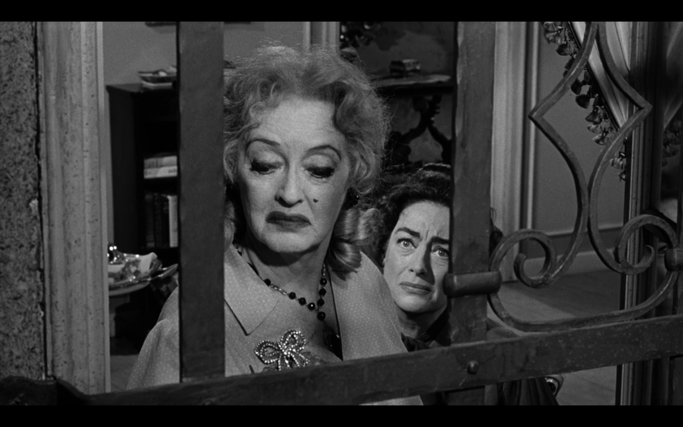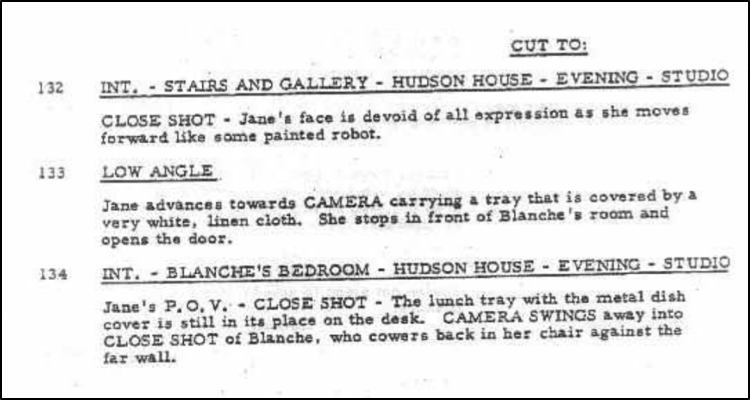Blueprints: "What Ever Happened to Baby Jane?"
 Thursday, April 26, 2018 at 12:01AM
Thursday, April 26, 2018 at 12:01AM This week on Blueprints, Jorge writes a letter to daddy.

Any screenwriting book, seminar, or four-year degree will tell you that screenwriting is all about showing, not telling. It should feel more like describing a house in a Craiglist ad than writing a novel. The script is being written so it can be shot, not read. However, just like any other “rule” in cinema, it’s made to be broken. In fact, those who break rules can sometimes transcend them.
What Ever Happened to Baby Jane?, the 1962 grand guignol classic, is best remembered for the bombastic performances of the two leads, and the drama that took place between them behind the scenes. But reading the script, it’s apparent that the story is charged with remarkable meaning, intention, and impulse. Often hidden in the lines that the audience is never going to read...
WHAT EVER HAPPENED TO BABY JANE?
Written by: Lukas Heller
Based on the novel by: Henry Farrell
[You can read the full script here. I will be talking about these pages and this scene.]
Whatever else can be said about What Ever Happened to Baby Jane? (its tricky categorization inside a particular genre, its place inside the careers of the two leads), the movie is at its heart a tightly-written, smart character study. Most of it takes place inside a house. Most if it revolves around only two people. And, apart from some body-dragging physical stunts, it’s almost entirely dialogue.
However, the film gets unexpected additional depth with the accompanying script by Lukas Heller. In the screenply, he describes the characters and actions like a novelist, informing every movement and line of dialogue with flowery detail.
This particular scene, the famous “But y’are, Blanche!” confrontation between the two sisters, takes about four minutes of screen time and five pages from the script. But while the movie depicts the first shots of Jane moving from the kitchen to Blanche’s room quite straightforwardly, the script takes about half a page to meticulously describe not only how Jane moves, but also how the camera is to follow her, as well as adding remarks about the character that the audience will never see.


What stands out most throughout the script is the way Heller uses action lines as a novelization of what’s taking place on screen, diving into thoughts and details that deeply inform the actions of the characters, but that in no way could be conveyed visually.
This style would probably be frowned upon by today’s straight-to-the-point industry (maybe it was frowned upon even back then, although embellished description was probably the lesser problem in that production). However, it gives the movie a fascinating depth knowing that there were additional, page-only words meant to deepen the characters more.




Admittedly, this style of writing gives little room for the actresses to act and the director to direct, since all is being laid out on the page quite explicitly. Perhaps that is why the practice is uncommon and less seen today. But it makes a case for the screenwriter as, well, a writer... someone who works with words and not just action lines, someone who uses description to not only describe a set, a costume, or a sound, but to inform a character’s internal world. Given that Baby Jane is, if nothing else, a movie about internal worlds, this novelist approach to the script feels fitting.
Though in a movie where the director, both the stars, and the studio felt they deserved total creative control, it makes sense why the ornate descriptions of a “blank, angry stare” or a “childishly simple thought” have gone widely unnoticed.
All this time, it could have been read.



Reader Comments (3)
All I can think of (and have been all day after reading this) is Alaska and Alyssa. Nonetheless, thanks for shining a light on the art of the overwritten screenplay. To be a fly on the wall to see/hear the actresses’ and director’s responses to the writer’s choices...
Yes, the movie looks v stagebound. I'm surprised tt no one adapted it to Broadway. Wld b a smsh w the right actresses n direction
The pictures on this blog remind me a lot of the pictures that appear when you solve a captcha. It's funny, but 10 years ago no one had even heard of this strange word. Today it's impossible to register on any self-respecting site without it. But is it as convenient as it seems at first glance? You know the answer yourself. Very often the question of solving the captcha becomes an insurmountable task. That is why there are sites where you can easily solve these problems. That is why pages are created on which you can always find solve captcha java and more, as well as useful tips and save yourself from a useless waste of your time.